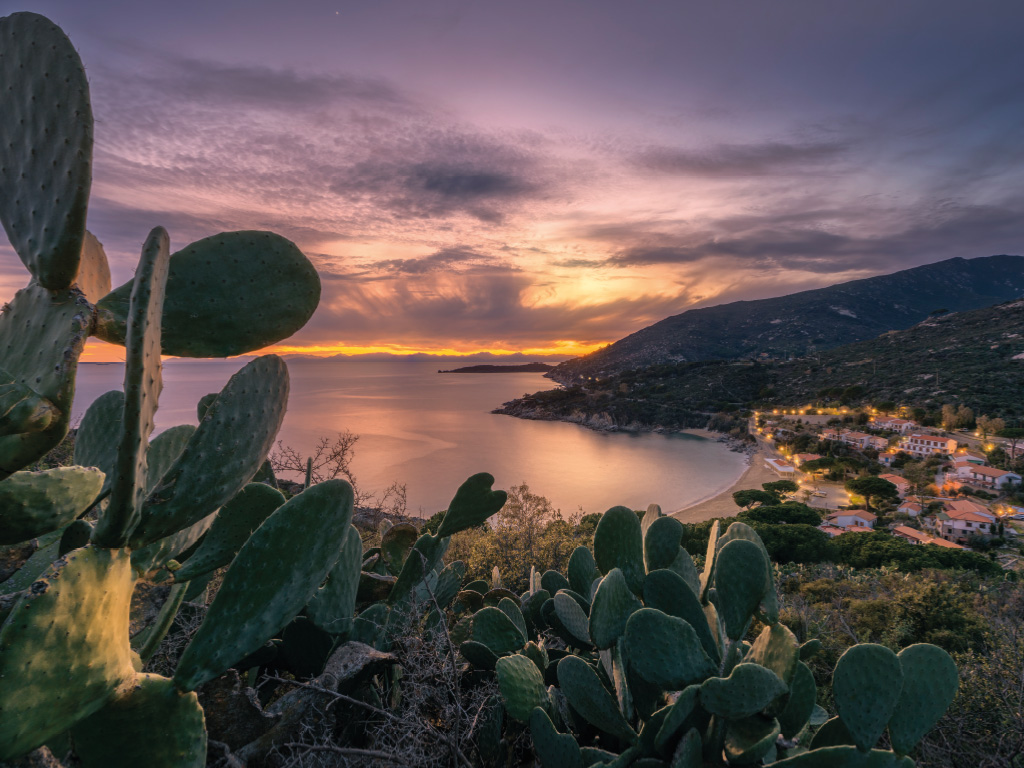Nel 1939, lo studio BBPR, fondato da Belgiojoso, Peressutti e Rogers, ricevette l’incarico, su indicazione di Adriano Olivetti, di elaborare un piano per lo sviluppo turistico dell’Isola d’Elba. In un contesto ancora segnato dal regime fascista, lo studio si distinse per una visione moderna e lungimirante, attenta alla valorizzazione del patrimonio naturale e culturale dell’Isola. Anticipando la sensibilità che avrebbe contraddistinto il secondo dopoguerra, e intuendo i pericoli di un abuso del territorio ancora intatto, il piano si fondava su alcuni principi guida: rispetto del paesaggio, valorizzazione dei centri storici e delle tradizioni locali, creazione di infrastrutture moderne e promozione di un turismo di qualità. Le nuove strutture, come alberghi e villaggi turistici, dovevano integrarsi armoniosamente con l’ambiente, essere funzionali e confortevoli. Il piano mirava ad attrarre un turismo colto, attento alla natura e alla cultura, evitando derive di massa che avrebbero potuto compromettere l’equilibrio dell’Isola. Il progetto includeva anche una forte componente civile e multidisciplinare, frutto della collaborazione con giovani architetti che soggiornarono a Marciana Marina e strinsero legami con la popolazione locale. La guerra interruppe la realizzazione del piano e segnò tragicamente la sorte di alcuni membri dello studio. Tuttavia, a distanza di oltre ottant’anni, il piano BBPR conserva tutta la sua attualità e si conferma un esempio di visione sostenibile e armoniosa dello sviluppo territoriale.
In 1939, the BBPR studio, founded by Belgiojoso, Peressutti and Rogers, was commissioned to draw up a plan for the development of tourism on the Island of Elba, featuring a contemporary vision that focused on the enhancement of the island’s natural and cultural heritage. Their plan was based on respect for the landscape, appreciation for the cultural heritage, the creation of modern infrastructures and the development of quality tourism. BBPR presented a model that today would be described as “sustainable”, one that would not alter the natural harmony of the island, integrating new buildings into the landscape, keeping the beauty of the coastline and its surrounding area intact. In addition, their plan included restoration and enhancement of historic centres, monuments and local traditions. The aim was to give tourists an authentic experience, helping them to get to know the island’s history and culture. They had envisaged modern, functional accommodation facilities, comfortable and in keeping with the surrounding environment. Their plan was to attract an elite type of tourism that would be interested in culture, nature and relaxation. They wanted to avoid mass tourism which could have compromised the equilibrium of the island. 80 years on, that plan is still valid if we want to save the beauty and the cultural identity of Elba.
Im Jahr 1939 wurde das Architekturbüro BBPR, gegründet von Belgiojoso, Peressutti und Rogers, beauftragt, einen Entwicklungsplan für den Tourismus auf der Insel Elba zu entwerfen. Dieser Plan zeichnete sich durch eine moderne Vision aus, die das natürliche und kulturelle Erbe der Insel in den Mittelpunkt stellte. BBPRs Konzept basierte auf dem Respekt vor der Landschaft, der Aufwertung des kulturellen Erbes, dem Ausbau moderner Infrastrukturen und der Förderung eines hochwertigen Tourismus. Sie schlugen ein Entwicklungsmodell vor, das man heute als „nachhaltig“ bezeichnen würde – ein Ansatz, der das natürliche Gleichgewicht der Insel bewahren sollte, indem neue Strukturen harmonisch in die Landschaft integriert wurden und die Schönheit der Küste sowie des Hinterlandes erhalten blieb. Ein wesentlicher Bestandteil des Plans war zudem die Restaurierung und Aufwertung historischer Stadtzentren, Denkmäler und lokaler Traditionen. Ziel war es, Besuchern ein authentisches Erlebnis zu bieten und ihnen die Möglichkeit zu geben, die Geschichte und Kultur der Insel hautnah zu erleben. Die geplanten Einrichtungen sollten modern, funktional und zugleich harmonisch in die Umgebung eingebettet sein. Der Fokus lag darauf, einen exklusiven Tourismus anzuziehen – Reisende, die sich für Kultur, Natur und Erholung begeistern, anstatt auf Massentourismus zu setzen, der das fragile Gleichgewicht der Insel gefährden könnte. Auch acht Jahrzehnte später bleibt dieser Plan aktueller denn je, wenn es darum geht, die Schönheit und kulturelle Identität Elbas für kommende Generationen zu bewahren.

